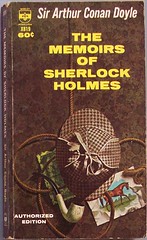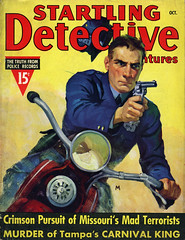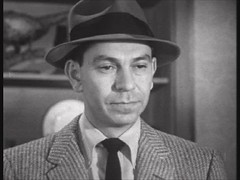Above: The cover to a collection of illustrations from the history of mystery and detective stories, found on Flickr.
All the discussion of variant detectives made me ponder what elements are essential to the archetype of the character and what traits have waxed and waned with the transitory phases of culture over. With the recent addition of a digital tuner to my television set, and Netflix vast "Instant Watch" library, I now have access to a large amount of old detective TV shows and movies. As I study sleuths, both modern and classic, I begin to gain a sense of the course the detective genre has taken over the years. In a way these decades-old characters can serve as data points which combine to chart a sort of evolutionary path for the modern American detective character. If examined in the proper manner the progress of fictional sleuths can provide some fascinating insights into both the essential elements of the detective archetype and our cultural development over the past-century or so. Consider the following:
Above: The cover of The Memoirs of Sherlock Holmes by Sir Arthur Conan Doyle, supplied through Flickr.
1800's-1920's- Since the earliest detective fiction stories by Edgar Allen Poe, through Arthur Conan Doyle, and on to the early works of Agatha Christie, the detective was essentially a puzzle maven. While the protagonist always displayed brilliant intellectual acumen, either as a natural talent in the case of Holmes and C. Auguste Dupin, or as acquired knowledge as with Miss Marple or Father Brown- the cases usually didn't require a genius to solve them. Often all of the evidence was presented to both the detective and the reader, and the challenge lay only in interpreting the information. In most stories the hero steps in after traditional crime fighters have failed and manages to solve the case simply by noticing a crucial misinterpretation, or making a keen-eyed observation, or providing some obscure or arcane factoid, or by simply rearranging the information into a decipherable pattern. None of this seems fitting of a genius. However when the starring sleuth appears to pull answers from thin air, and the story disguises the facts to confound the reader, and stresses how terribly impressive the hero's deductions (if you can even call them that) are, the reader winds up getting a thrill out of the story's climactic revelation just the same. While the creators of these stories may not have been capable of crafting problems worthy of their detective creations, they did establish the central mythological elements and tropes that would define the detective genre through the present day.Above: A cover to a typically racy pulp magazine featuring crime and detective stories, found on Flickr.
1930-40's- The next generation of crime fiction took a dramatic leap, branching it out to several different directions. Commonly referred to for the stylized mystery movies of the period both print and film detectives have been labeled as film noir in retrospect. The noir period was heavily influenced by the racy pulp magazines of the day and the underground, culturally subversive films that spawned a new sub-genre. As detective stories transitioned to new media, and the culture of the world seemed to spin out of control, the creators added new elements and explored new concepts. Now in the hands of pulp writers the stories took on a darker tone, the cases involved a seedier variety of crime, and the plots drifted away from straight-forward problems with simple solutions. Meanwhile filmmakers switched the focus onto action sequences instead of extensive sections of expository dialogue, and -to make sure the actors earned their paychecks- the characters became more fleshed out than the ciphers that preceded them. The changing tone of the art and the foreboding nature of contemporary events produced some significant changes in theme. Now the cases transcended from puzzles -that required collecting or organizing information- to true mysteries- that require investigating areas that resist comprehension, like human psychology, and require gathering new evidence or making deductive or intuitive leaps. Even more significantly the detectives themselves took on some new characteristics. No longer do their intellectual gifts separate them out as a special asset to the local authorities. In fact, the protagonists increasingly came from outside the traditional authority structure, most often as private investigators. In this era, their morality, their dogged pursuit of "justice" no mater what cost, often puts them in conflict with traditional authority figures. I would imagine the creators of these stories saw a world that seemed to be falling apart, where the authorities no longer could be trusted, and no simple solutions seemed possible, and they crafted heroes who fit that environment and had the skill to overcome it. Once this new generation of detectives rose to prominence, the detective genre would largely be defined by a dialectic between the original Holmes detectives and the new prototype of the noir-style.
Above: A photograph of Jack Webb the actor who portrayed Sgt. Joe Friday on Dragnet.
1950-60's- Detectives of this era were first and foremost social servants, almost always employees of a benevolent social institution, such as the local police force or the FBI. Now that the world was at peace these detectives represented an America returning to work. During this time frame, television became a popular source of crime stories. As TV filled a niche in the daily lives of the audience, the stories told came to reflect how the audience thought about their own private lives. So the detective stories of the days were filled with friendly functionaries, either blue-collar beat cops in TV shows like Adam-12 or white-collar detectives from Dragnet. These characters approached crime fighting with a workmanlike attitude, going about their jobs with gray flannel suits and stoic expressions. Once again they usually did not display special intellectual powers. In fact rarely did these characters encounter any cases that were difficult to solve. Usually the perpetrators were apprehended simply through persistent pursuit, and the cases were open and shut with all the evidence plain for all to see. (All cases were open and shut, because all situations involving crime were open and shut.) If anything made the detectives of this era distinct from other characters, it was their loyalty to their values and the system they served. Their strong morality made them servants to authority rather than rebels to it. If ever the detective stories represented the hopes and dreams of an era it was during this period. The crime fighter was just an average person with a good heart who brought order to the streets. In the same manner, Americans hoped that staying true to their values and doing their jobs in good faith would bring order to their lives and the world as a whole. Several popular TV series on the air today, such as the Law & Order franchise or the CSI family of shows, still bear many of the hallmarks of this period's detective stories.Above: An artistic portrayal of the television detective Kojak, created by Lisa Brawn.
1970's- Here we come to an interesting little span, where I feel the detective genre reached a bit of a nadir. The focus almost entirely shifted away from the crimes and their solutions, and instead focused on the heroes and their personalities. If the stories had been about the deductive gifts or investigative prowess of the protagonists, we might still have had something to add to the genre. Instead we got a collection of TV shows like Kojak and The Rockford Files, which were more interested in creating lovable TV stars than exploring stories of crime. While the milieu of detective work still provides ample fodder for conflict and action sequences, the emphasis was definitely more on the leading roles eccentric character traits or individual charms. In a way I feel this was a reflection of the changing American middle class. No longer did people find comfort playing a role in building the great society, now they wanted to feel they were the star of their own story, no matter how mundane. The job you did became less important as people began to put more emphasis on how you did your job. I feel the legal and medical dramas of the time displayed similar sensibilities and represent part of a larger cultural shift that also involved crime shows. The content of the detective series did change in one interesting way. The problems confronting the sleuths became more like the seemingly insolvable mysteries of the noir period, with an increased focus on a criminal's motives or a lack of clear evidence. However since the detectives rarely had to think up a solution or explanation of a crime -usually a climactic gun fight would take care of that problem- this did not actually add new thematic depths to the genre. I think the mysteries were just easier to write than puzzles when all the writer's attention was going to character details. In some ways the star vehicles of today, like Monk and House, are the descendants of these shows.
Above: A painting illustrating the characters and scenery of the TV show Miami Vice, painted by Pepe Cardosa.
1980-90's- I would describe the detective fiction of this era as the progeny of two earlier strands of the genre. We have the obvious continuation of the 1970's, where the focus of the narratives had less to do with the unraveling of mysteries and more to do with character examinations of the featured detectives. In some cases (e.g. Miami Vice, Wiseguy, Homicide: Life on the Street), the purpose of the show was mostly about exploring the personal lives of the crime fighters and dissecting the ways in which their personal neuroses where caused by, or contributed to, their detective work. I feel this trend reached its apex with the first season of NYPD Blue where the show's creators successfully used soap-opera plot lines to overshadow the police procedural elements of the series. Accordingly the distinguishing characteristics of this new batch of gumshoes came from their ability to manage or endure personal crisis rather than overcome the challenges of crime fighting. Beneath this continuing trend, we find the dark undercurrent of a return to noir sensibilities. As the storylines reflected the hardships of our heroes, the subtext spoke to a world soaked in violence and amorality. American culture seemed to struggle with themes of societal collapse and moral decay. Perhaps not coincidentally these were also major themes of the Reagan revolution and rise of the religious right occurring contemporaneously. As with the 1930's and 40's the American public felt the world had spun out of control, and even traditional authority figures struggled against problems like gang-violence, drug abuse, and corruption. In an interesting evolution from the noir period, the morality of the characters no longer spurred the on to eventual victory, rather it provided a bulwark to help them stand against the ceaseless tide of chaos and injustice. Though any given story may show the hero surviving a particular crisis, the suggestion that eventually the dark nature of the world would erode away all the good in the character seemed to be applied universally. Concurrently in the world of detective literature, novels focused increasingly on characters from outside the traditional authority structure. Books found niche markets by featuring protagonists from minority perspectives who took an unconventional perspective on the institutions of law enforcement. Most notably female detectives rose to a new level of prominence and brought a new morality as well. Rather than reinforcing the 1950's imagery of white men imposing their version of order on society, these investigative women seemed more sympathetic to the victim. This theme resonated with the resurrected noir sentiment, here casting the victim as a casualty of the world's cruelty and the detective as the sole means for justice.
Above: A photograph of David Caruso as Horatio Caine from CSI: Miami, found on Flickr.
2000's- As the private-eyes of the 1940's gave way to the beat cops of the 1950's so to did a generational shift occur with the new millennium. The detectives at the end of the 20th century were grunts in the nationwide war on crime. In some cases they were stoic, in other cases neurotic, and in still others they were pathetic (in the Aristotelian sense). Generally though, their personalities and personal drama distinguished them from the standard crime fighter. The latest generation of detectives embodies a strong return to their Holmes-ian roots. Now the detectives are once again servants of traditional authorities. They prove their value through displays of intellectual sharpness rather than moral fortitude. Examine TV mystery series like House M.D., The Mentalist, and Bones, and you will find many echoes of Holmes. Like Holmes, the stars of these series frequently display demonstrably superior skills of observation and mental agility. Like Holmes, they find their intellect hinders their ability to interact with others. Also like Holmes, they are mostly domesticated creatures, whose occasional misbehavior masks that they perpetually preserve the status quo. Unlike Holmes, they are typically specialists with intensive knowledge of one area and occasional blind spots for other topics. They are the hedgehogs to Holmes' fox. I have come to think of this era as recasting the detective as a technocrat. Here I find this era is best typified by the C.S.I. franchise. Each show under the C.S.I. label presents a group of moderately attractive functionaries with hollow personalities. They sport a wide array of crime solving gizmos and casually toss scientific terminology (which may not always be realistic, but is always dumbed down to the audience's level). Once again the story element of true mystery -where complicated and ineffable variables are involved- has been superseded by the use puzzle plots- where all you need is the dedication to identify and arrange all the evidence.
Now, I will readily admit that this is in no way a complete history of detective fiction. I simply tried to assemble the most comprehensive analysis I could using my own relatively limited familiarity with the genre. Anyone who knows more about detectives in literature, especially more recent works, or has a better memory for classic TV shows, should please share any insights or wisdom you have in the comment section. For my part, I think I have gathered enough information here to draw some conclusions about the detective archetype in my next entry.
To be continued . . .








1 comment:
Interesting series of posts. I find it particularly intriguing that the oddball Batman of the 1950s and 1960s fits the mold of the times, right down to the workman-like attitude and the stoic expression.
Post a Comment